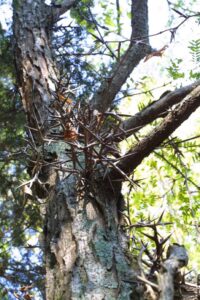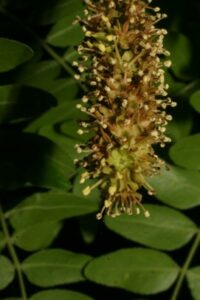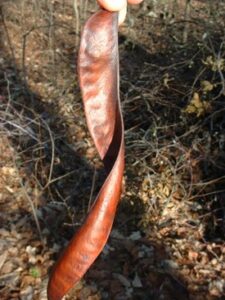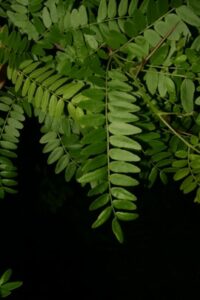Botanical Name:
Gleditsia triacanthos
Family Name:
Fabaceae
Description:
Honeylocust is a fast-growing, medium to large, deciduous tree with a spreading canopy. It is easily recognized in its native habitat by its long, branched thorns on the trunk and branches and by the long, flat, dark reddish brown seedpods. It is adaptable to a variety of growing conditions, and the many thornless cultivars (Gleditsia triacanthos f. inermis) are commonly planted in urban environments. The bark of larger trees is gray-brown with long, raised strips. The canopy is rounded to flattened at the top and spreading.
Size:
60-80’ tall; 60-80’ spread
Habitat and Range:
Honeylocust is native to most of the eastern United States and adjacent Canada west of the Appalachians, and its range extends as far west central Kansas. It occupies a variety of habitats, from riverine bottomlands to dry upland and disturbed sites. The species is not shade tolerant and can be an early invader into abandoned old fields and pastures.
Attributes:
Honeylocust has separate male and female trees. Both produce short clusters of small green flowers. The females produce large, flattened, curved, or twisted, dark reddish-brown seedpods. Leaves are once or twice pinnately compound with small, rounded leaflets that turn yellow in the fall.
Wildlife Value:
The seedpods are eaten by deer, and squirrels will readily extract and eat the seeds.
Did you know?
• Honeylocust was an important tree in Cherokee culture, serving as a source of food (sugars from the pods), medicine, wood for game sticks, and as a spiritual icon.
• Although native to eastern North America, honeylocust is invasive in several other countries, such as Argentina, Australia, and South Africa, where it has been introduced as a fodder tree.
Benefits to Our Community (based on carbon dioxide sequestered, storm water runoff avoided, and air pollution removed each year):
Over the next 15 years, this tree will give back $3,750 worth of benefits to our community.




